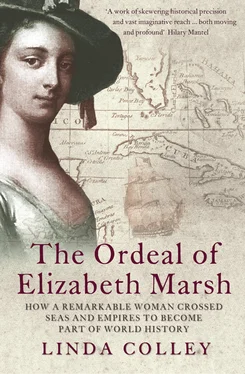Upon the French being landed on the island of Menorca, Commodore Edgcumbe gave him an order … to proceed from thence in His Majesty’s ship the Princess Louisa to Gibraltar, and there to take upon him the duty of Master Shipwright. 11
By now there were five Royal Navy ships off Mahón, ‘moored head and stern in line across the harbour’s mouth’, but still manifestly too few to engage the 120 French warships and transports assembling off the coast of Ciutadella, to the west of the island, or to slow for very long the troops that these vessels were disgorging. Two of these British warships left on 21 April, which was when Milbourne Marsh carefully finished up and signed his remaining official paperwork, and ‘the same day the enemy appeared on this side of Mahón’. The following day, a Thursday, the forty-gun Princess Louisa with the Marsh family on board, together with the Dolphin and the Portland , slipped away to Gibraltar. 12 She was rescued, but not saved.
For it is now that Elizabeth Marsh begins to struggle out of the meshes of family plots and transcontinental forces and events, and seeks to take charge of her own life. She arrives in Gibraltar on 30 April 1756. Within two months, she has determined to sail to England by way of Lisbon. Although by this stage Britain and France are formally at war, and the Mediterranean is criss-crossed by French and British warships under orders to ‘take, sink, burn or otherwise destroy’ each other’s naval and merchant vessels, she insists on setting sail, initially in defiance of her parents’ wishes, and as a lone female traveller among men.
She has her private reasons for acting this way, but she can also make a prudential case for her decision. After just three days in Gibraltar, Milbourne Marsh has been able to compile a report on its naval facilities and defences. The British have long neglected the fortress for reasons of economy, and his assessment is uncompromising and discouraging:
The capstans, partners and frames [are] entirely decayed, the mast house, boat house, pitch house, smiths shop and cable shed all decayed, and tumbling down; the yard launch wants a thorough repair, and in case there may be a necessity to careen or caulk any of His Majesty’s ships, there is neither floating stages for that service, or boat for the officers to attend their respective duties; the shed within the new mole gates that was used for repairing sails in, likewise the shed for the use of the artificers are both decayed and tumbling down.
This, and more, is what he proceeds to tell Admiral John Byng, who is also newly arrived at Gibraltar, under instructions to sail with ten warships to relieve the besieged British garrison on Menorca. Even before Byng sets out, Milbourne’s damning report has therefore encouraged him to begin contemplating failure. ‘If I should fail in the relief of Port Mahón,’ he informs his superiors in London on 4 May, ‘I shall look upon the security and protection of Gibraltar as my next object.’ 13
Subsequently, these words will be interpreted by the senior officers at Byng’s court martial as evidence of a lack of determined resolution and aggressiveness on his part. Yet this is not altogether fair. Gibraltar, a three-mile-long rocky promontory off southern Andalusia in Spain with no source of fresh water at this time except for the rain, is like ‘a great man of war at anchor’. 14 It is formidable, a natural fortress, but with weaknesses corresponding to its strengths. The Rock gives its British occupiers a strategically key position from which to monitor the straits between the Mediterranean and Atlantic. If it is closely besieged from the sea, however, there is nowhere for its inhabitants to retreat except into Spain. Reports from diplomats and spies have been circulating since March 1756 that if Menorca falls (as it does at the end of June), France will move on to attack Gibraltar, and then offer both of these territories back to Spain in return for the loan of its naval fleet in the war against Britain. 15 If the French do attack Gibraltar – and if Spain turns hostile – how can the fortress defend itself without adequate stores, or the dockyard facilities necessary to keep a fighting navy at sea and in action?
Because he is thinking along these lines, Byng will decide to retreat after his fleet’s inconclusive encounter with the marquis de la Galissonière’s French squadron on 20 May 1756. He will hurry back to defend Gibraltar, leaving Menorca’s garrison to its fate, and so ultimately condemn himself to a naval firing squad. For the men of the Marsh family, however, Byng’s anxieties about the poor state of Gibraltar’s naval dockyard and defences have substantial compensations. ‘It requiring a proper person to inspect into and manage these affairs,’ Byng informs London, ‘I have taken upon me to give Mr. Milbourne Marsh … an order to act as Master Shipwright … and have given him orders to use his best endeavours to put the wharf etc. in the best condition he can, for very soon they will be wanted.’ 16 The added responsibility boosts Milbourne’s annual salary from £150 to £200, and this is in addition to the accommodation and food the navy allows him. By July, John Marsh is also in naval employ, working as clerk to his father, who no longer has the time to write his own letters. Elizabeth Marsh’s situation is necessarily different. For her, there can be no job. If a Franco-Spanish force lays siege to Gibraltar, there may be no easy means of escape this time, especially for a single, twenty-year-old woman who is associated with the British. Moreover, now that the war has reached Europe, Gibraltar itself is filling up with troops and is increasingly crowded and unhealthy. There are over a thousand men confined in its naval hospital, and every day some of them die. 17
All this enables Elizabeth Marsh to rationalize her decision to leave and to persuade her parents to agree, but she is also influenced – indeed misled – by her past. She is used to sailing in large, well-crewed, well-disciplined warships that are designed to take punishment as well as give it, and accordingly she has no fear of the sea. But the Ann , on which she embarks on the afternoon of 27 July, is a battered, unarmed 150-ton merchantman, loaded with casks of brandy, and with only ten crewmen. The man in overall charge is James Crisp, a nominally British merchant based in Barcelona who is already known to the Marsh family; and there are two other passengers, an Irish trader called Joseph Popham who is in his late forties, and his adolescent son William. 18 Since it is wartime, the Ann sails in convoy with fourteen other merchant vessels bound for Lisbon and under the protection of the forty-four-gun Gosport . This too misleads Elizabeth, for naturally she trusts the Royal Navy. Unfortunately, and like most sea officers, Captain Richard Edwards dislikes convoy duty, and he is also peculiarly bad at it. On the Gosport’s previous voyage, from Plymouth to Gibraltar, he has more than once lost sight of all thirty-four vessels entrusted to his care. In the case of this new Lisbon convoy, the fog that is so common in this stretch of the Mediterranean puts a further strain on his abilities. Although there is ‘moderate and fair weather to begin with’, one day out from Gibraltar the mist is so thick that he can no longer see any of the fifteen merchantmen sailing with him. Edwards orders the Gosport ’s rowing boats to be hoisted aboard so as to make up speed, and fires its guns to signal his location. 19 Those on the Ann hear the shots, and on the morning of 30 July catch a last glimpse of the Gosport , seven miles away. The Ann ’ s Master desperately carries ‘all the sail he could, in order to keep up with the man of war, even to endangering our lives, for there was six feet [of] water in the hold, before any one knew of it’. Used to the sea, but not to the limitations of small merchantmen, Elizabeth Marsh, by her own admission, was ‘entirely ignorant of the danger we had been in until it was over’. 20
Читать дальше












